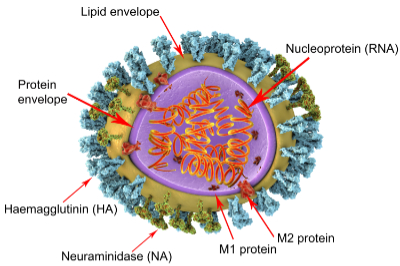Rapid diagnosis of influenza is essential in controlling the spread of infection and effective clinical patient management. Influenza rapid test kits are supporting progress in this area. For the detection and subsequent treatment of influenza, a rapid test can be a major support for clinicians.
Clinical Background
 Influenza is an acute viral infection of the respiratory tract that is highly infectious with a usual incubation period of one to three days. The disease is characterised by the sudden onset of fever, chills, headache, myalgia and extreme fatigue. Other common symptoms include a dry cough, sore throat and stuffy nose.
Influenza is an acute viral infection of the respiratory tract that is highly infectious with a usual incubation period of one to three days. The disease is characterised by the sudden onset of fever, chills, headache, myalgia and extreme fatigue. Other common symptoms include a dry cough, sore throat and stuffy nose.
For otherwise healthy individuals, influenza is an unpleasant but usually self-limiting disease with recovery usually within two to seven days. The illness may be complicated by (and may present as) bronchitis, secondary bacterial pneumonia or, in children, otitis media. Influenza can be complicated more unusually by meningitis, encephalitis or meningoencephalitis.
The risk of serious illness from influenza is higher amongst children under six months of age and in those with underlying health conditions such as respiratory or cardiac disease, chronic neurological conditions, or immunosuppression and pregnant women.
Influenza immunisation has been recommended in the UK since the late 1960s, with the aim of directly protecting those in clinical risk groups who are at a higher risk of influenza associated morbidity and mortality. The list of conditions that constitute a clinical risk group where influenza vaccine is indicated are reviewed regularly by the Joint Committee on Vaccination and Immunisation (JCVI).
- 2000 - policy was extended to include all people aged 65 years or over (see later for age definition).
- 2010 - pregnancy was added as a clinical risk category
- October 2014 - JCVI advised that morbid obesity (defined as BMI 40+) should be considered a risk factor for seasonal influenza vaccination.
- 2012 - JCVI recommended that the programme should be extended to all children aged two to less than seventeen years old. The phased introduction of the extension of the influenza programme to children began in 2013
More information about clinical risk groups and vaccination can be found in the Influenza Green book Chapter 19 and NICE (National Institute for Health and Care Excellence) Guidance
Influenza Virus
There are three types of influenza virus: A, B and C. Influenza A and influenza B are responsible for most clinical illness. Transmission is by droplets, aerosol, or through direct contact with respiratory secretions of someone with the infection and influenza spreads rapidly, especially in closed communities. Most cases in the UK tend to occur during an eight- to ten-week period during the winter.
 The timing, extent and severity of seasonal influenza can all vary. Influenza A viruses cause outbreaks most years and it is these viruses that are the usual cause of epidemics. Large epidemics occur intermittently.
The timing, extent and severity of seasonal influenza can all vary. Influenza A viruses cause outbreaks most years and it is these viruses that are the usual cause of epidemics. Large epidemics occur intermittently.
Changes in the principal surface antigens of influenza A – haemagglutinin and neuraminidase – make these viruses antigenically labile. Minor changes described as antigenic drift occur progressively from season to season. Antigenic shift occurs periodically, resulting in major changes and the emergence of a new subtype with a different haemagglutinin protein. Because immunity from the previous virus may not protect completely against the new subtype, the population may have little or no immunity, and this may therefore lead to widespread epidemics or even a pandemic.
Influenza B tends to cause less severe disease and smaller outbreaks overall. The burden of influenza B disease is mostly in children when the severity of illness can be similar to that associated with influenza A.
Diagnostic Methods
Influenza activity is monitored in the UK through a variety of schemes based in primary and secondary care. Weekly reports are collated by Public Health England (PHE) and additional information for England is provided by the Royal College of General Practitioners (RCGP), for Scotland by Health Protection Scotland, for Wales by Public Health Wales and for Northern Ireland by the Public Health Agency.
More information about Influenza surveillance in the UK can be found HERE
Virus detection in the laboratory is usually performed, using multiplex molecular test platforms, on fluid from respiratory secretions, nose and throat swabs. A wide variety of test platforms and assay combinations are now available commercially from global manufacturers, including influenza rapid tests for use in near patient testing or urgent triage.
Additional, more complex tests to identify the specific influenza strains are available and include phenotypic and genotypic drug resistance by gene sequencing methods.
These test results can take a matter of hours or several days, depending on the complexity of the test and the time required to transport the patient samples to the laboratory.
Rapid influenza diagnostic tests can help in the diagnosis and management of patients who present with signs and symptoms compatible with influenza. An influenza rapid test can be useful for helping to determine whether outbreaks of respiratory disease, such as in nursing homes and other settings, might be due to influenza. By assisting in the right diagnosis and treatment of influenza, a rapid test can help to reduce the substantial morbidity, mortality and costs associated with the infection, cut down on inappropriate antibiotic prescriptions and reduce the number of repeat doctor visits.
Rapid Influenza tests
Rapid influenza diagnostic tests work by detecting parts of the virus that stimulate an immune response. Typically these tests provide results within 10-15 minutes and are designed for near patient testing. Rapid tests using an immunochromatographic method (ICT) are relatively inexpensive and these near patient tests are based on the visibility of a coloured line in the device when the sample is positive.
Interpretation of the result is by eye, although many manufacturers now offer small reading instruments to avoid the subjectivity and potential misinterpretation of results. Typically the sensitivity of this type of influenza rapid test can vary from 50 - >80% with a specificity of 90 – 95%, false negatives may occur but false positives are rare. Performance data of the test will vary depending on the manufacturer.
A variety of commercial rapid molecular tests are also available and detect genetic material of the virus. These tests are highly specific and more sensitive than ICT tests, however they may have a longer assay time, require specific instrumentation, and are usually significantly more expensive.
Recently, new advances in fluorescent technology has allowed the development of rapid influenza tests with a significantly higher sensitivity, approaching that of molecular methods. SD Biosensor Assay times from 1.5 – 10 minutes and automatic result interpretation using a low cost analyser suggests that with the continual need for reliable and cost effective near patient test solutions for detecting influenza, a rapid test via this method may provide a cost effective point of care test for the future.